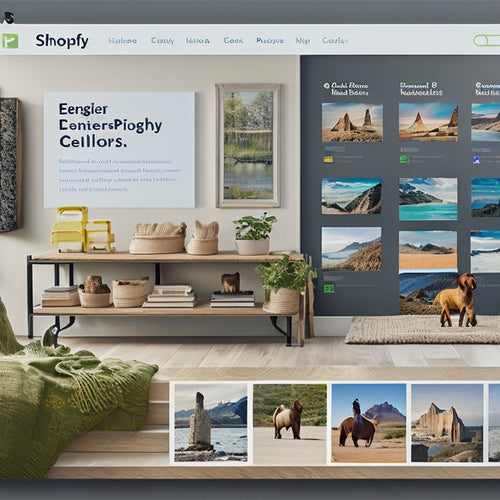
5 Tips to Seamlessly Integrate Digital Products Online
Share
You're one step closer to seamlessly integrating digital products online by focusing on five key areas. First, define a digital product strategy that aligns with your business goals and target audience needs. Next, choose an ecommerce platform that supports your strategy, scales with your business, and enhances customer experience. Then, optimize your product information to build trust and convince customers to buy. Develop a seamless checkout process to minimize friction and reduce cart abandonment. Finally, guarantee secure and reliable delivery to protect customer data and provide timely access to purchases - and that's just the starting point for a customer-centric digital product experience.
Key Takeaways
• Align your digital product strategy with business goals and target audience needs to ensure a seamless online experience.
• Choose an ecommerce platform that supports your strategy, scales with your business, and enhances customer experience.
• Optimize product information with concise descriptions, high-quality images, and engaging content that resonates with your target audience.
• Develop a seamless checkout process with minimal steps, clear labeling, and customized payment options to reduce friction.
• Ensure secure and reliable delivery by implementing robust encryption methods, content delivery networks, and clear instructions for accessing digital products.
Define Your Digital Product Strategy
To successfully integrate digital products online, you must first define a clear digital product strategy that aligns with your business goals and target audience needs. This involves conducting thorough market research to identify your ideal customer segments and their pain points. By understanding your customers' needs and preferences, you can create products that meet their expectations and stay ahead of the competition.
Customer segmentation is pivotal in this process, as it enables you to tailor your products to specific groups, increasing their relevance and appeal.
Additionally, a competitive analysis will help you identify gaps in the market and areas for product differentiation. By analyzing your competitors' strengths and weaknesses, you can develop unique selling points that set your products apart.
Choose the Right Ecommerce Platform
You'll need a sturdy ecommerce platform that can support your digital product strategy, scale with your business, and provide a seamless customer experience. This is a critical decision, as it will impact your online store's functionality, flexibility, and ultimately, your customers' satisfaction.
When selecting an ecommerce platform, consider the following key factors:
-
Customization options: Look for a platform that offers flexibility in design, layout, and workflow to align with your brand's unique needs.
-
Scalability and reliability: Guarantee the platform can handle high traffic, sales spikes, and sudden changes in demand without compromising performance.
-
Payment gateways and integrations: Choose a platform that supports multiple payment gateways, such as PayPal, Stripe, or Apple Pay, and integrates with your existing systems and tools.
Optimize Your Product Information
Now that you've selected a suitable ecommerce platform, it's time to focus on creating high-quality product information that accurately represents your digital offerings and resonates with your target audience. This is important in building trust and convincing potential customers to make a purchase.
Start by updating product descriptions to make sure they're concise, clear, and engaging. Use a tone that speaks to your target audience and highlights the benefits of your digital products. Avoid using jargon or overly technical terms that might confuse customers.
Next, improve product images to showcase your digital products in the best possible light. Use high-quality visuals that demonstrate how your products work or what they can achieve. Consider using infographics, screenshots, or demo videos to give customers a better understanding of your products.
Develop a Seamless Checkout Process
Streamline your checkout process by minimizing steps, reducing form fields, and clearly labeling each stage, ensuring a frictionless experience that gets customers from cart to confirmation quickly and confidently. You want to make it easy for customers to complete their purchase, reducing the likelihood of abandoned carts and increasing conversions.
To achieve this, consider the following strategies:
-
Offer customized payment options: Provide customers with a range of payment methods, including digital wallets and cryptocurrencies, to cater to their unique needs and preferences.
-
Implement a one-click checkout: Allow repeat customers to save their payment and shipping information, making it quick and easy for them to complete future purchases.
-
Use clear and concise language: Avoid using technical jargon or complicated terms that might confuse customers, and instead use simple and intuitive language that guides them through the checkout process.
Ensure Secure and Reliable Delivery
As customers finalize their purchases, they expect their digital products to be delivered quickly and securely. It's essential to implement a dependable delivery system that protects their sensitive information and ensures timely access to their purchases. You can achieve this by utilizing robust encryption methods, such as SSL/TLS, to safeguard customer data during transmission.
Additionally, consider using a content delivery network (CDN) to reduce latency and guarantee fast delivery of digital products.
To further enhance the delivery process, you should have a thorough customer support system in place. This could include providing clear instructions on how to access digital products, as well as offering multiple channels for customers to reach out to your support team in case of issues.
Frequently Asked Questions
How Do I Handle Product Returns and Exchanges Online?
"Did you know 30% of online shoppers return items? You'll build trust by crafting clear return policies, ensuring customer satisfaction through hassle-free exchanges and refunds, and leveraging technology to streamline the process."
Can I Integrate My Physical Store With My Online Platform?
You can integrate your physical store with your online platform by syncing online inventory with in-store stock, ensuring seamless sales integration, and providing an omnichannel customer experience that boosts sales and customer loyalty.
What Analytics Tools Should I Use to Track Product Performance?
You'll need analytics tools that track social media performance, optimize conversion rates, and analyze customer behavior to inform data-driven decisions, while also benchmarking against competitors to stay ahead in the market.
How Do I Protect My Products From Being Copied or Stolen?
'A million thieves are waiting to pounce on your digital products, but you're not going to let them! You'll fortify your brand with ironclad copyright protections, digital watermarking, and anti-piracy measures to guarantee brand authenticity and safeguard your intellectual property.'
Can I Offer Personalized Product Recommendations to Customers?
You can offer personalized product recommendations to customers by leveraging personalization techniques, ensuring data privacy, and using targeted marketing to boost customer engagement, ultimately driving sales and loyalty.
Related Posts
-
Understanding Shopify Sitemaps: Beginner's Walkthrough
Through the exploration of Shopify benefits, tips for e-commerce businesses, and helpful tutorials for Shopify SEO, ...
-

What Can Shopify Integrate With
This article aims to explore the various integration options available for Shopify. By examining the benefits of int...
-

The Power of Referral Programs: Boost Your Shopify Sales
Referral programs have emerged as a strategic tool in word-of-mouth marketing, aiming to leverage existing customers...

